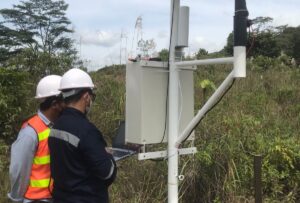Feature: The crucial relationship between air quality and weather
Air quality is an essential factor in creating smarter, healthier communities. Yet, too many communities struggle to effectively monitor the quality of the air their citizens breathe. Vaisala explains how their Air Quality and Weather Insights can provide vital information to communities.
Outdoor air pollution is one of the biggest environmental risks to people’s health. With 91% of the world’s population living in locations where the WHO’s air quality guidelines levels are not met.
Since air quality is always connected to the weather, air quality measurements are much more valuable if they are accompanied by real-time data about wind speed and direction, temperature, humidity, and other factors directly impacting pollution and its dispersion.
Weather drivers affecting air quality include wind speed and direction, precipitation, temperature, and the atmospheric boundary layer (ABL).
Wind speed and direction influence pollution dispersion and are important factors for deciding on network locations and creating alerts or interventions during times of heavy pollution. Precipitation can cause pollutants from the atmosphere to be washed downward and can sometimes reduce street and road dust emissions.
Temperature impacts the behaviour of air and the pollution it carries. ABL behaviour defines the air volume into which pollutants are diluted. Combining ABL and air quality observations improves situational awareness and the quality of forecasts and advisories.
By integrating air quality sensors with versatile, reliable weather sensing solutions, smart cities can now combine enhanced air quality measurements with weather intelligence to get the whole picture of air quality in their community.
Building an Air Quality Sensor Network
Air quality has traditionally been monitored by government authorities using methods defined by federal regulations. While these methods typically have a high degree of accuracy and traceability, the high cost and large size of the refined analyzer technologies used to obtain measurements means these types of stations are typically installed in small quantities in limited locations rather than as networks that would characterize the air quality distribution in an area.
By combining ground-based measurements with boundary-layer profiling, decision-makers have access to in-depth, accurate information that empowers better decisions to mitigate air pollution. With the technology for small, cost-effective air quality sensors advancing in the last several years, today’s sensors can easily be deployed on lampposts, streetlights, buildings or wherever else they are needed to complement reference-grade stations.
There are four key factors to consider in the design and implementation of an air quality sensor network:
- Representativeness of locations
- Meteorological conditions
- Microscale effects and sensor siting
- Areas of interest
It is important that sensor locations are chosen in a way that represents a certain type of environment in the city and to understand the source of the pollutants. Meteorological conditions are key to designing network locations and knowing the prevailing conditions in an area. With situational meteorological measurements, authorities can better understand the drift of local emissions and pollutants.
The Components of Air Quality Monitoring Systems
To help communities better understand air quality, Vaisala — a global leader in weather, environmental and industrial measurement — has developed myriad solutions unique in their ability to provide holistic air quality and weather insights for dramatically improved decision-making.
Ideal for supplementary air quality networks, the Vaisala Air Quality Transmitter AQT530 measures the most important air pollutants — particulate matter (PM1, PM2.5, PM10) and criteria gases (nitrogen dioxide (NO2), nitrogen monoxide (NO), ozone (O3) and carbon monoxide (CO)) — and environmental conditions (temperature, humidity and pressure) in one compact package.
Because combining meteorological data with air quality measurements is helpful, the Vaisala Weather Transmitter WXT530 Series is a unique collection of cost-effective sensors that accurately and reliably measure the six most important weather parameters — wind speed and direction, air pressure, temperature, humidity, and rainfall.
With boundary layer data being crucial for a complete picture of factors affecting air quality, Vaisala ceilometers measure the height and variations in the boundary layer. Leveraging pulsed diode lidar technology and single-lens optics, Vaisala ceilometers accurately measure the mixing layer height and other boundary layers aloft, providing insight into the volume and quantity of air in which pollutants can be mixed — ultimately affecting pollutant concentration.
Wind also affects the generation and transport of pollutants, stressing the need for local wind profile measurements throughout the atmospheric boundary layer. To collect local wind profile measurements, Vaisala has two lidar technologies: WindCube and WindCube Scan. WindCube measures the wind profile up to 300 meters with 20 simultaneous heights measured per second, while WindCube Scan measures the wind profile at farther ranges across the boundary layer through different scanning scenarios.
By combining ceilometer and wind profile measurements, authorities are equipped with the full picture — the boundary layer assessment and the wind conditions up to the boundary. Tying it all together, Vaisala Beacon Station is a compact, scalable, plug-and-play platform that provides weather and environmental observations depending on what sensors are attached to it.
Whether providing environmental protection agencies with air quality, weather and high-quality air resolution monitoring or providing city leaders with visibility into air quality and weather insights, Vaisala’s air quality monitoring solutions allow decision-makers to actively inform citizens, increase awareness and decrease the effects of pollution. Clearly, dense air quality sensor networks are key to enabling modern, effective air quality management that helps make city air more breathable.
At the end of the day, the public benefits of enhanced air quality measurement go beyond health advisories and safety. With the right access to the right information, people gain a deeper connection to their environment and new ways of thinking about business and community, which is especially important as people strive for smarter communities while dealing with significant global trends like climate change and rapid urbanization.


















